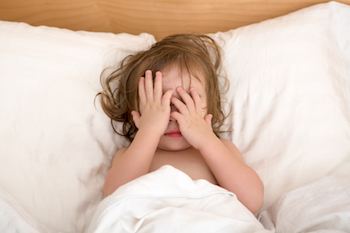This article focuses on research that suggests a possible link between the frequency of nightmares during childhood, and the eventual onset of psychotic experiences. The article discusses that nightmares occur most frequently during Rapid Eye Movement sleep, one of five sleep stages that most individuals will experience over an average night of sleep. During this time, the body's muscles are paralyzed and the brain undergoes an intense increase of activity.

This research studied the incidences of nightmares and night terrors that were experienced by 6,700 children in the United Kingdom. These children were assessed a total of six times between the ages of 2 and 9 years, and then again at 12. This study revealed that children reporting one period of nightmares between the ages of 2 and 9 years presented a 16% increased risk of having a psychotic experience in adolescence. For children that experienced three or more periods of sustained nightmares, this risk increased by 56%.
Overall, children that continued to experience nightmares at the age of 12 were 3.5 times more likely to suffer psychotic experiences which includes hallucinations, interrupted thoughts or delusions, during their early adolescence periods. Experiencing night terrors at the age of twelve doubled the risk of undergoing a psychotic episode.
I chose to focus on an article regarding nightmares because of this alternating chapter pattern that has presented either Amabelle's dreams or her memories. Within the first chapter of the book, she mentions that, "It's either be in a nightmare or be nowhere at all. Or otherwise simply float inside these remembrances, grieving for who I was, and even more for what I've become."
The ninth chapter of the book dives into one of Amabelle's nightmares, where she depicts how her parents drowned in the river. She states how if it was not for two young river boys that grabbed her, she would have followed her parents into death. One of the river boys says, "Unless you want to die, you will never see those people again."
Again Amabelle's nightmares are displayed in chapter 23, where she states that she dreams of the sugar woman. The depiction of the scene through Amabelle's eyes is rather terrifying, as she questions this woman, asking who she is and why she appears the way she does. She mentions that she begins to think that Sebastien is responsible for this dream, that the sugar woman is what remains of a dead love he carries with him and into her arms.
And finally, the last connection that I want to discuss between this book and the article is when Yves begins talking in his sleep, with his eyes wide open. Sebastien reveals that this has been a regular occurrence since the death of Joel, only a few days had passed at this point. As dawn approaches, Yves consistently says, "Papa, don't die on that plate of food." Sebastien later says that they were unable to sleep, as Yves was "squawking like a crazy parrot all night long."
No comments:
Post a Comment